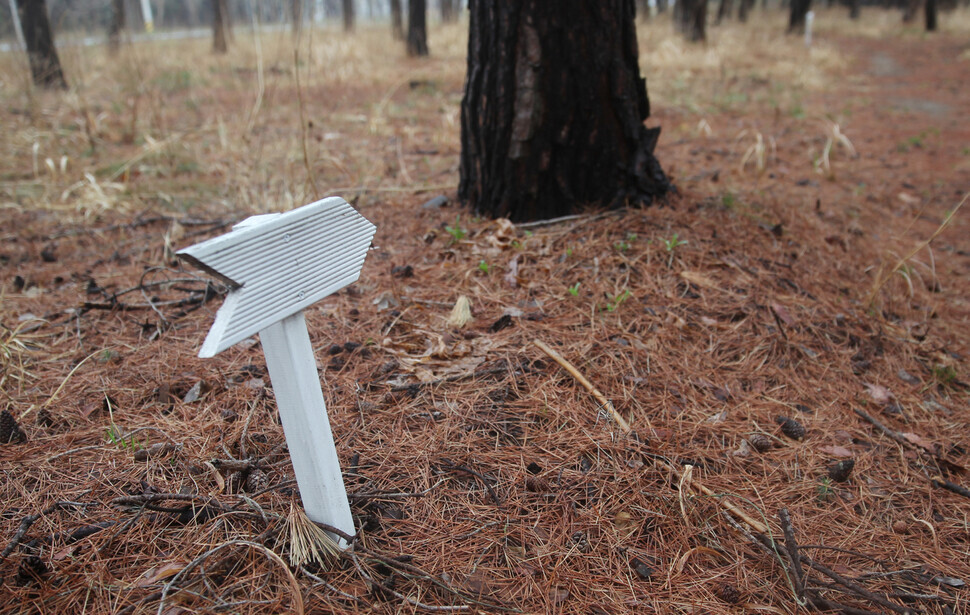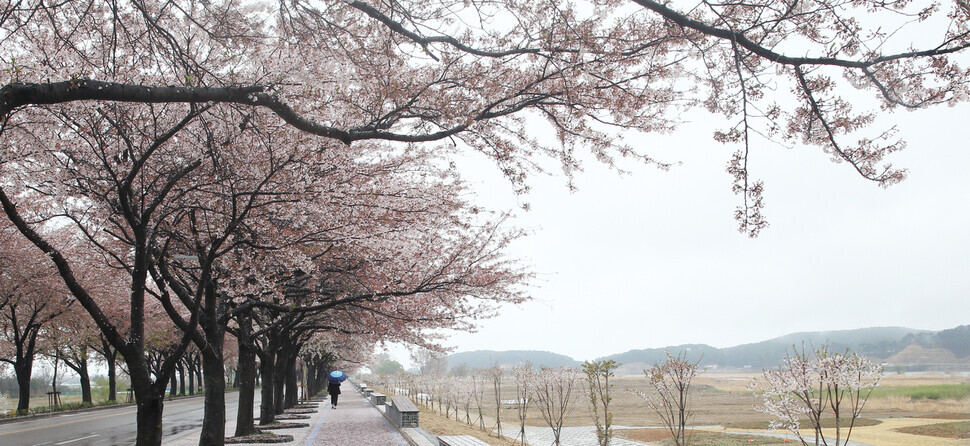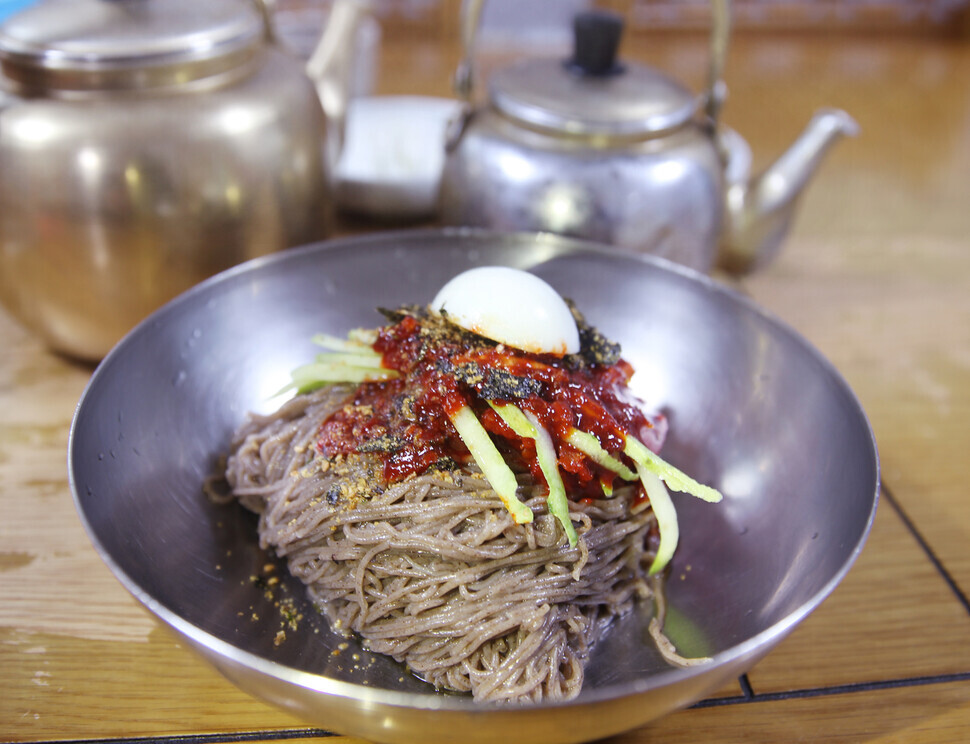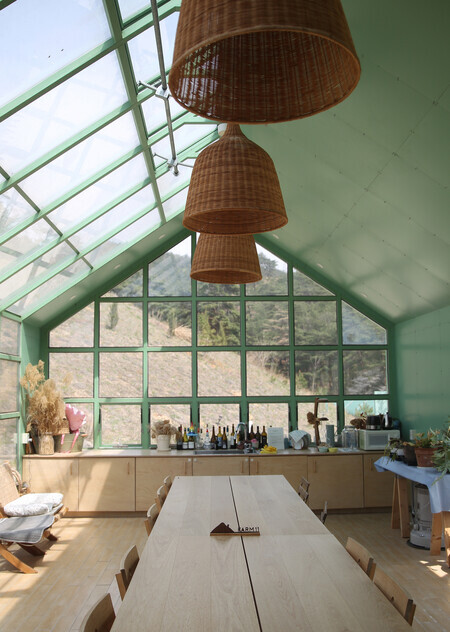hankyoreh
Links to other country sites 다른 나라 사이트 링크
[Korea travels] On secret beachside walking paths, Yangyang’s hidden charm shines through

In the past, Yangyang was treated as the hinterlands compared with Gangwon Province’s major travel destinations like Gangneung and Sokcho. Now it has risen to become a nationwide tourism draw — and surfing has played a large role in that.
Surfers in their 20s and 30s began visiting with the 2015 establishment of the Yangyang Surfyy Beach area around Hajodae, which bills itself as “Korea’s first exclusive surfing beach.”
Since then, swanky cafes, stores, and guesthouses have opened their doors, with pop-up stores held for luxury brands along with events such as test-drives of automakers’ newest models. These days, the number of non-surfers coming to Yangyang has been rapidly rising. According to statistics from the Yangyang County Office, around 1.3 million tourists visited last year.
The influx of visitors has turned Yangyang into a more boisterous place — meaning that those who favor peace and quiet no longer have much reason to visit.
But a closer look shows a lot of simple and pleasant tourist options in Yangyang too. The Hankyoreh has selected a few of them to recommend for those considering a walking tour.

As you leave the front entrance of the Gangwon International Education Institute (840, Seonsayujeok-ro, Sonyang-myeon, Yangyang-gun) and walk for three to four minutes along County Road 5 in the direction of the Sol Beach Yangyang resort, you will come across a sign that reads “Solbaram Walking Path.” That’s the starting point for this walking course.
Crossing over the loosely hanging “no parking” warning and heading toward the sea, you may hear some unusual sounds. When I stopped here on April 5, the winds were particularly strong.
“Whoong whooong whoooooong.”
Four years ago, I took a night train to Lisbon. I can remember the howling as thick splashes of rain beat against the windows. As night settled in and the windows turned black, the sound of rain took on a faintly eerie quality — like the cries of an animal being kept on a chain.
Now I was hearing the same howling sound again in Yangyang. Drawn to it as if under a spell, I arrived at Songjeon Beach. It turned out to be the sounds of the rough waves. There wasn’t a traveler in sight.
“This is a very quiet beach that surfers and tourists don’t know about,” explained Hwang Myeong-sook, a team leader with the county office’s tourism division.
There’s a reason the setting is less well known. As recently as last summer, there was a military-grade barbed wire fence in place here.
Stretching from Yangyang’s Naksan Bridge to Songjeon Beach, the fence was taken down last autumn as part of a larger project to remove military-owned barbed wire from along the East Sea coast. Meanwhile, local residents went about creating a trail.
“We made the walking trail for residents,” explained Choi Jin-man, the 61-year-old village head in Gapyeong, a community in the township of Sonyang.
“It was thick with pine trees, some of which were cut down to make it easier to walk,” he added, describing the forest trail as “something only locals know about and people from other regions don’t.”
The Solbaram Walking Path experience truly begins as you turn away from Songjeon Beach. At this point, it becomes impossible to continue walking along the shore. There is a military base stationed here, and civilian access is prohibited.
A warning message from the unit’s leader reads, “Violations will be punished in accordance with Article 24 of the Protection of Military Bases and Installations Act.”
I soon see a white arrow-shaped sign among the pine trees. It acts as a kind of compass, helping visitors orient themselves on the deserted forest trail. Those who don’t follow the areas could end up running into tomb mounds.
“These [mounds] have long been there — anonymous tombs that have subsided over time,” Choi explained.
Even in the middle of the day, passing by them can seem like something out of a horror movie. But when the living experience dread in the face of death, that tends to come from a lack of reflection. The living ought to have more of a sense of awe toward the dead, considering what kind of life they might have lived and what sort of difficult experiences they might have lived through.
Soon enough, the outstretching branches of the pines bring peace of mind. Some of the trees appear quite young. They whisper messages of comfort. This “carbon offset forest” has been recognized by the South Korean government as a carbon sink.
The forest trail is like a cotton blanket. Pinecones knocked off the trees by the spring rains the day before lie strewn about like horse droppings.
As you keep walking, you come across a military guard post. Photography here is verboten.
The trail soon splits in two. Taking the left path leads you to a small athletic facility. The Gangwon International Education Institute lies at the end of the right path.
The experience is quite different from the sweetness and saltiness of urban walking paths. It’s a humble and pleasant forest trail.
☞ “Solbaram Walking Path” sign > Songjeon Beach white arrow sign > Gapyeong guard post gate > Gangwon International Education Institute: Around 1 hour

“The redfin schools have come. It’s amazing,” said 60-year-old Sokcho resident Lee Bo-bae while looking at redfins during a visit to Namdae Stream on April 4. Lee’s hometown visit was planned to coincide with the spawning season between April and June.
In 2007, work began on creating an artificial branched river (saetgang) measuring 3 meters across and around 2 kilometers in length on Namdae Stream, which originates at Mount Odae’s Duro Peak and flows through Yangyang Township in Yangyang County. It was part of a “Namdae Stream renaissance project” underway since 2014.
As you walk north from Yangyang Bridge, it isn’t just the redfins in the stream that greet you. There are also two stepping-stone bridges that curve like arrows. Over 260 stones have been laid out in an orderly arrangement.
A round trip takes 15 minutes. For visitors, it’s a marvelous spectacle — but for residents, it’s a means of making a living.
These days, the trend of consumption-oriented tourism has been giving way to a greater emphasis on the importance of local travel, which involves interacting with local residents and experiencing their lives more closely. In addition to the stepping-stone bridge, there was also a local travel connection in the telephone number of a Chinese restaurant I saw at Yangyang Bridge’s pier — offering a glimpse at everyday lives in the community.
Walking for three or four minutes along the road to the left of Yangyang Bridge, you can see a rainwater pumping station. Also visible is the Namdae Stream cherry blossom road, with rows of gorgeously blossoming cherry trees along it.
When I visited on April 5, some of the petals had showered like snowflakes in the previous day’s rains. They were now gone, but some remained tenaciously hanging as if battling to see the spring through.
But even if all but one of the petals have fallen away, what of it? It makes the trip worthwhile just to see the last vestiges of the season.
☞ Yangyang Bridge > stepping-stone bridge (round trip) > Yangyang Bridge > rainwater pumping station > Namdae Stream cherry blossom road > Naksan Bridge: Around 1 hour and 40 minutes

Across the road from the Ganghyeon Township Office (3509, Donghae-daero, Ganghyeon-myeon, Yangyang-gun) stretches a deck path. Underneath that path is the expanse of a pebble beach.
The beach includes a mix of everything from large stones the size of an adult person’s face to tinier ones shaped like eggs. Walking over them is twice as taxing as stepping over flat land. Injuring your ankles is a real risk; hiking boots are recommended.
The sound of the waves striking the petals is a bit unexpected. It’s almost like music. Not like a classical piece or a pop song — more like the kind of unique, creative music that Ryuichi Sakamoto, the world-renowned composer who recently passed away, spent his whole life producing.
Sakamoto described music as a “visual art” — a “creative activity of realizing changes in linear time” (“Musik Macht Frei”).
Is time on a pebble beach also linear? What sort of changes might have occurred for the traveler on foot?
☞Deck road (across from Ganghyeon Township Office) > Jeongam pebble beach > Hemingway Road sign: Around 1 hour (round trip)
Cherry blossom buckwheat noodles and a natural farmThe real bases for transformation in travel destinations tend to emerge through intersections between the lives of locals and recent transplants. Yangyang is no exception.
Examples of this include the families that operate the restaurant Danyang Myeonok, which opened during Korea’s occupation by Japan, and Farm11, where the residents left behind Seoul to start a new life in Yangyang. On April 4, I met people who represent Yangyang’s older and newer faces.

“We don’t really know when we opened. All we know is that it was sometime during the Japanese occupation,” said Jang Seong-geum, 63, the current owner of Danyang Myeonok (3, Nammun 6-gil, Yangyang-eup, Yangyang-gun).
The founder of the restaurant is Cho Yeong-hui (who passed away in 1965), the mother-in-law of Jang’s mother-in-law, Yoon Eul-ok (who passed away in 2014). Cho left her hometown of Danyang when she got married at 16 and settled in Yangyang. That’s why the restaurant has “Danyang” in the name.
Cho started to make buckwheat noodles (makguksu) using actual firewood to cook them. Produce that her husband, a farmer, poured his heart and soul into, went into the dish. They only sold the noodles during markets. The food tasted great, and of course, it became a hit.
“Grandma had a knack for flavor. She also was a fan of soju,” said Go Gwang-ok, 72, co-owner of the restaurant and Jang’s sister-in-law (Go Gwang-hee, 69). The noodles were dubbed “cherry blossom buckwheat noodles,” as they sold especially well during cherry blossom season.
Yoon learned and inherited Cho’s secret recipe. She started to sell Hamheung Naengmyeon in 1965. Something new was added to the history of the restaurant. The shop moved to its current location around that time. It was also from this point that seasoned flounder started to get added on top of the noodles.
“Mother went through a lot during the 70s,” Jang goes through the hazy memories in her mind to talk about her mother-in-law. Go joins her sister-in-law reminiscing. “She was kind and loved to cook. She especially loved feeding other people.”
The secret behind the wondrous flavors in the dishes is in the ratio of the ingredients and the spices. According to Jang, “The buckwheat is ground by hand at a local mill, and the flounder is from the east coast.” Most buckwheat noodle restaurants use ready-prepared buckwheat flour that they can buy in bulk. The care and thought that are put into the ingredients of every dish are the hallmarks of the 100-year-old restaurant.
Using chili powder, not gochujang, in the seasoning is key to unlocking the flavor. Gochujang can make sauces thick and clingy. Jang has also set out to modernize the recipe. “Mother would always do things without measuring anything, but I wrote everything down and put numbers on them. I’ve quantified everything. I even use a salinity meter.”
The noodles at Danyang Myeonok are a legacy passed down through three generations of women, and the spicy, savory taste demonstrates the hard work put into them through the years.

As you climb the hill along the track, you come across a glass greenhouse of a pastel hue. This is Farm11 (42 Wondanggol-gil, Seo-myeon, Yangyang-gun, Gangwon-do), a natural farm. The exotic greenhouse, garden, three accommodation buildings, bakery, and community space were built on this rocky mountain because of 63-year-old Choi Gil-soon’s dream and vision.
Choi was born and raised in Gangneung, but spent most of his life in Seoul, where he worked in planning and marketing for a large company. When he went overseas on business trips, he was drawn to the farms and gardens he could see there. He dreamed of making a space like that and “took the plunge” in 2013 to retire. He bought the land in 2015 and opened Farm11 in 2019.
“I thought that I’d divide my life into quarters. If I say that I’ll live for 100 years, the first 25 years were the years in which I grew up. The next 25 years were devoted to my family. The third quarter is for myself, and the remaining quarter will involve me giving back to everything and everyone.” He is currently in the third quarter of his life, and lives in Farm11.
Why this rocky mountain? “I’ve been traveling for years, even going so far as to just sleep in my car. I came to this region by chance, and I liked the scenery here.” The scenery at the foot of the South of Mount Seorak and Mount Jumbong looks like a picture postcard. The total land area is about 11 acres (49,000 square meters). That’s why the farm has the number 11 in the name.
Choi’s wife, Song Seong-rim, 58, bakes, and his daughter, Choi Seo-won, 31, gardens. All sorts of wildflowers and other blossoms bloomed in the garden, which would rival any garden you’d see in a European palace. With its simple, restrained beauty, Farm11 quickly captured the attention of South Korea’s youth, and it became a “hip” travel destination on their social media.
But recently, he has had a lot on his mind.
“One day I started to wonder if I was happy. I started this because I wanted to be happy, but now I’m not so sure. I feel as if I’m getting further and further away from living a beautiful life of less, and of making a positive difference in the world by doing something meaningful.”
Taking a break also requires a lot of courage.
The bakery has been closed for five months. He ended the interview with one comment: “Life doesn’t have answers.”
Photos and article by Park Mee-hyang, staff reporter
Please direct questions or comments to [english@hani.co.kr]

Editorial・opinion
![[Column] Has Korea, too, crossed the Rubicon on China? [Column] Has Korea, too, crossed the Rubicon on China?](https://flexible.img.hani.co.kr/flexible/normal/500/300/imgdb/original/2024/0419/9317135153409185.jpg) [Column] Has Korea, too, crossed the Rubicon on China?
[Column] Has Korea, too, crossed the Rubicon on China?![[Correspondent’s column] In Japan’s alliance with US, echoes of its past alliances with UK [Correspondent’s column] In Japan’s alliance with US, echoes of its past alliances with UK](https://flexible.img.hani.co.kr/flexible/normal/500/300/imgdb/original/2024/0419/2317135166563519.jpg) [Correspondent’s column] In Japan’s alliance with US, echoes of its past alliances with UK
[Correspondent’s column] In Japan’s alliance with US, echoes of its past alliances with UK- [Editorial] Does Yoon think the Korean public is wrong?
- [Editorial] As it bolsters its alliance with US, Japan must be accountable for past
- [Guest essay] Amending the Constitution is Yoon’s key to leaving office in public’s good graces
- [Editorial] 10 years on, lessons of Sewol tragedy must never be forgotten
- [Column] A death blow to Korea’s prosecutor politics
- [Correspondent’s column] The US and the end of Japanese pacifism
- [Guest essay] How Korea turned its trainee doctors into monsters
- [Guest essay] As someone who helped forge Seoul-Moscow ties, their status today troubles me
Most viewed articles
- 1[Column] The clock is ticking for Korea’s first lady
- 2Samsung barricades office as unionized workers strike for better conditions
- 3[Editorial] When the choice is kids or career, Korea will never overcome birth rate woes
- 4S. Korea, Japan reaffirm commitment to strengthening trilateral ties with US
- 5[News analysis] After elections, prosecutorial reform will likely make legislative agenda
- 6Japan officially says compensation of Korean forced laborers isn’t its responsibility
- 7[Editorial] As it bolsters its alliance with US, Japan must be accountable for past
- 8[Editorial] Does Yoon think the Korean public is wrong?
- 9Why Israel isn’t hitting Iran with immediate retaliation
- 10[Interview] Learning about the Sewol tragedy through BTS